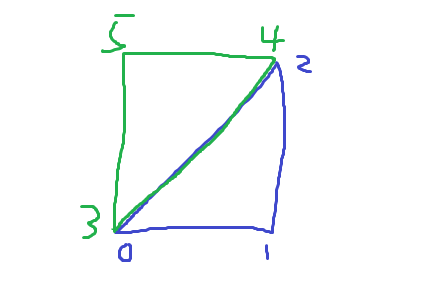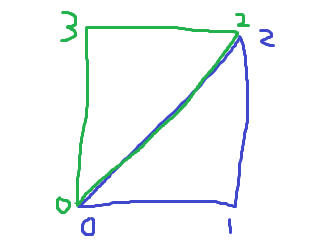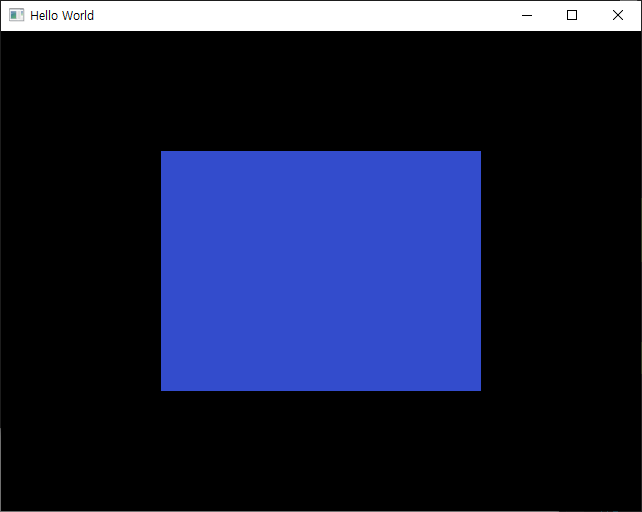목표
- 인덱스 버퍼의 사용과 이해
공부 내용
삼각형 그리기
- 삼각형을 하나 그리려면, 버텍스 3개가 필요하다.
1
2
3
4
5
6
float positions[6] =
{
-0.5f, -0.5f,
0.0f, 0.5f,
0.5f, -0.5f,
};
- GPU는 전달받은 버텍스들을 순서대로 확인하여 3개씩 짝지어서 하나의 폴리곤을 그려준다.
- 이 때, 3개의 버텍스가 순서대로 시계 반대 방향으로 위치해야 폴리곤의 전면이 그려진다.
사각형 그리기
- 사각형을 하나 그리려면 삼각형이 2개 필요하므로, 결국 버텍스 6개가 필요하다.

-
그런데 두 삼각형이 두 개의 버텍스를 공유하므로, 여섯 개의 버텍스를 전달하는건 버텍스를 두 개만큼 손해보는 것과 같다.
-
따라서 버텍스는 네 개만 전달하고, 이를 인덱스 버퍼를 이용해 중복되는 버텍스를 재사용하게 된다.

인덱스 버퍼 사용
- 정점 위치 데이터 수정
1
2
3
4
5
6
7
float positions[] =
{
-0.5f, -0.5f, // 0
0.5f, -0.5f, // 1
0.5f, 0.5f, // 2
-0.5f, 0.5f, // 3
};
- Index 데이터 정의
1
2
3
4
5
GLuint indices[] =
{
0, 1, 2,
0, 2, 3
};
- IBO(Index Buffer Object) 생성, 바인딩, 데이터 연결
1
2
3
4
GLuint ibo;
glGenBuffers(1, &ibo);
glBindBuffer(GL_ELEMENT_ARRAY_BUFFER, ibo);
glBufferData(GL_ELEMENT_ARRAY_BUFFER, sizeof(indices), indices, GL_STATIC_DRAW);
- Window Loop 내에서 그려주기
1
2
//glDrawArrays(GL_TRIANGLES, 0, 6); // 원래 코드
glDrawElements(GL_TRIANGLES, 6, GL_UNSIGNED_INT, nullptr);
-
glDrawElements
- 배열 데이터로부터 프리미티브를 렌더링한다.
GLenum mode |
어떤 프리미티브를 렌더링할지 결정 |
GLsizei count |
렌더링할 버텍스의 개수 지정 |
Glenum type |
indices 배열 엘리먼트의 타입 지정 - GL_UNSIGNED_BYTE - GL_UNSIGNED_SHORT - GL_UNSIGNED_INT |
const GLvoid* indices |
GL_ELEMENT_ARRAY_BUFFER로 바인딩되어 현재 버퍼 데이터를 저장하는 배열의 첫 번째 인덱스 |
return void |
리턴 값 없음 |
실행 결과

Source Code
Basic.shader
#shader vertex
#version 330 core
layout(location = 0) in vec4 position;
void main()
{
gl_Position = position;
};
#shader fragment
#version 330 core
layout(location = 0) out vec4 color;
void main()
{
color = vec4(0.2, 0.3, 0.8, 1.0);
};
CustomFunctions.hpp
1
2
3
4
5
6
7
8
9
10
11
12
13
14
15
16
17
18
19
20
21
22
23
24
25
26
27
28
29
30
31
32
33
34
35
36
37
38
39
40
41
42
43
44
45
46
47
48
49
50
51
52
53
54
55
56
57
58
59
60
61
62
63
64
65
66
67
68
69
70
71
72
73
74
75
76
77
78
79
80
81
82
83
84
85
86
87
88
89
90
91
92
93
94
95
96
97
98
99
100
101
102
103
104
105
106
107
108
109
110
111
112
113
114
115
116
117
118
119
120
121
122
123
124
125
126
127
128
129
130
131
132
133
#pragma once
struct ShaderProgramSource
{
string VertexSource;
string FragmentSource;
};
/// <summary>
/// 쉐이더 파일을 읽어서 버텍스, 프래그먼트 쉐이더 스트링 가져오기
/// </summary>
/// <param name="filePath">쉐이더 파일 경로</param>
/// <returns>ShaderProgramSource { Vertex, Fragment }</returns>
static ShaderProgramSource ParseShader(const string& filePath)
{
enum class ShaderType
{
NONE = -1, VERTEX = 0, FRAGMENT = 1
};
ifstream stream(filePath);
string line;
stringstream ss[2];
ShaderType type = ShaderType::NONE;
// 스트림에서 한 줄씩 읽어오기
while (getline(stream, line))
{
// #shader 라인을 통해 버텍스, 프래그먼트 쉐이더 시작점 인식
if (line.find("#shader") != string::npos)
{
if (line.find("vertex") != string::npos)
{
type = ShaderType::VERTEX;
}
else if (line.find("fragment") != string::npos)
{
type = ShaderType::FRAGMENT;
}
}
// #shader가 없는 부분에서는 스트링 스트림에 라인 추가
else
{
ss[(int)type] << line << '\n';
}
}
return { ss[0].str(), ss[1].str() };
}
/// <summary>
/// 쉐이더 소스 코드를 입력받아 쉐이더 객체 생성하고 컴파일
/// </summary>
/// <param name="source">쉐이더 소스 코드</param>
/// <param name="type">GL_VERTEX_SHADER 또는 GL_FRAGMENT_SHADER</param>
/// <returns>컴파일된 쉐이더 객체의 ID 또는 0(에러)</returns>
static GLuint CompileShader(GLenum type, const string& source)
{
// 빈 쉐이더 객체 생성
GLuint shaderID = glCreateShader(type);
const char* src = source.c_str();
// 쉐이더 코드를 쉐이더 객체로 변환하여 위의 쉐이더 객체 id에 바인딩
glShaderSource(shaderID, 1, &src, nullptr);
// 쉐이더 컴파일
glCompileShader(shaderID);
// 쉐이더 컴파일 결과 검증
GLint result;
glGetShaderiv(shaderID, GL_COMPILE_STATUS, &result);
// 컴파일이 실패한 경우
if (result == GL_FALSE)
{
int length;
// 로그의 길이값을 length에 받아오기
glGetShaderiv(shaderID, GL_INFO_LOG_LENGTH, &length);
// 스택에 배열 동적 할당
char* message = (char*)_malloca(length * sizeof(char));
// 로그 메시지 받아오기
glGetShaderInfoLog(shaderID, length, &length, message);
// 에러 메시지 출력
cout << "Failed to Compile "
<< ((type == GL_VERTEX_SHADER) ? "Vertex" : "Fragment")
<< " Shader"
<< endl;
cout << "\nError Message :" << endl;
cout << message << endl;
// 쉐이더 메모리 해제
glDeleteShader(shaderID);
_freea(message);
return 0;
}
return shaderID;
}
/// <summary>
/// 프로그램, 쉐이더 객체 생성
/// </summary>
/// <param name="vertexShader">버텍스 쉐이더 소스 코드</param>
/// <param name="fragmentShader">프래그먼트 쉐이더 소스 코드</param>
/// <returns>생성된 프로그램 객체의 ID</returns>
static GLuint CreateShader(const string& vertexShader, const string& fragmentShader)
{
// 빈 프로그램 객체 생성
GLuint programID = glCreateProgram();
// 쉐이더 컴파일
GLuint vs = CompileShader(GL_VERTEX_SHADER, vertexShader);
GLuint fs = CompileShader(GL_FRAGMENT_SHADER, fragmentShader);
// 프로그램에 쉐이더 장착, 프로그램 링킹, 검증
glAttachShader(programID, vs);
glAttachShader(programID, fs);
glLinkProgram(programID);
glValidateProgram(programID);
// 쉐이더 메모리 해제
glDeleteShader(vs);
glDeleteShader(fs);
return programID;
}
Application.cpp
1
2
3
4
5
6
7
8
9
10
11
12
13
14
15
16
17
18
19
20
21
22
23
24
25
26
27
28
29
30
31
32
33
34
35
36
37
38
39
40
41
42
43
44
45
46
47
48
49
50
51
52
53
54
55
56
57
58
59
60
61
62
63
64
65
66
67
68
69
70
71
72
73
74
75
76
77
78
79
80
81
82
83
84
85
86
87
88
89
90
91
92
93
94
95
96
97
98
99
100
101
102
103
104
105
106
107
108
109
110
111
112
113
114
115
116
117
118
119
120
121
122
123
124
125
126
127
128
129
#include <GL/glew.h>
#include <GLFW/glfw3.h>
#include <iostream>
#include <fstream>
#include <sstream>
#include <string>
using namespace std;
#include "CustomFunctions.hpp"
int main(void)
{
GLFWwindow* window;
/* Initialize the library */
if (!glfwInit())
return -1;
/* Create a windowed mode window and its OpenGL context */
window = glfwCreateWindow(640, 480, "Hello World", NULL, NULL);
if (!window)
{
glfwTerminate();
return -1;
}
/* Make the window's context current */
glfwMakeContextCurrent(window);
// glewInit은 rendering context를 만들고 난 이후에 해야 함
if (glewInit() != GLEW_OK)
{
cout << "GLEW INIT ERROR" << endl;
}
// 간단히 GLEW 버전 확인
cout << glGetString(GL_VERSION) << endl;
/******************************************************************
* VBO - Vertex Position *
******************************************************************/
// Vertex Attribute : 위치 데이터
float positions[] =
{
-0.5f, -0.5f, // 0
0.5f, -0.5f, // 1
0.5f, 0.5f, // 2
-0.5f, 0.5f, // 3
};
// VBO(Vertex Buffer Object) ID 생성
GLuint vbo;
// VBO 객체 생성
glGenBuffers(1, &vbo);
// VBO 타입 바인딩
glBindBuffer(GL_ARRAY_BUFFER, vbo);
// VBO에 위치 데이터 연결
glBufferData(GL_ARRAY_BUFFER, sizeof(positions), positions, GL_STATIC_DRAW);
// 정점 속성 정의
glVertexAttribPointer(0, 2, GL_FLOAT, GL_FALSE, sizeof(float) * 2, 0);
// 정점 속성 활성화
glEnableVertexAttribArray(0);
/******************************************************************
* IBO - Vertex Indices *
******************************************************************/
// Index Data
GLuint indices[] =
{
0, 1, 2,
0, 2, 3
};
// Index Buffer Object 생성, 바인딩, 데이터 연결
GLuint ibo;
glGenBuffers(1, &ibo);
glBindBuffer(GL_ELEMENT_ARRAY_BUFFER, ibo);
glBufferData(GL_ELEMENT_ARRAY_BUFFER, sizeof(indices), indices, GL_STATIC_DRAW);
/******************************************************************
* Shader *
******************************************************************/
// 쉐이더 파일 읽어오기
ShaderProgramSource source = ParseShader("Resources/Shaders/Basic.shader");
string vertexShader = source.VertexSource;
string fragmentShader = source.FragmentSource;
cout << "\nVERTEX\n" + vertexShader +
"\nFRAGMENT\n" + fragmentShader << endl;
// 쉐이더 객체 생성 및 컴파일, 프로그램 객체 생성
GLuint shaderProgram = CreateShader(vertexShader, fragmentShader);
// 쉐이더 프로그램 객체 사용
glUseProgram(shaderProgram);
/******************************************************************
* Loop *
******************************************************************/
while (!glfwWindowShouldClose(window))
{
/* Render here */
glClear(GL_COLOR_BUFFER_BIT);
// 폴리곤 그리기
glDrawElements(GL_TRIANGLES, 6, GL_UNSIGNED_INT, nullptr);
/* Swap front and back buffers */
glfwSwapBuffers(window);
/* Poll for and process events */
glfwPollEvents();
}
// 프로그램 객체 메모리 해제
glDeleteProgram(shaderProgram);
glfwTerminate();
return 0;
}